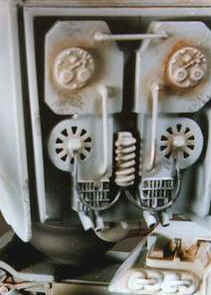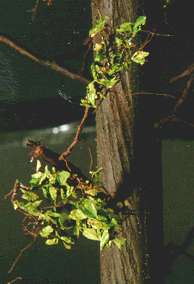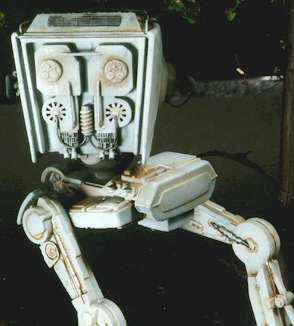AT-ST in the forests of Endor
by Janne Nilsson
English translation by Martin Waligorski
All Terrain Scout Transport (AT-ST) is one of the amazing array of sci-fi vehicles envisioned in the Star Wars series.
amazing array of sci-fi vehicles envisioned in the Star Wars series.
Undeservingly, some Star Wars fans refer to it as Chicken Legs. In spite of this, it is one of my very favourites.
The history
The Empire has developed an entire range of armored combat vehicles. Except for the AT-ST, there was the mammoth, devastating AT-AT walker, the one-man AT-PT walker, the QH-7 Chariot light assault vehicle, the A5 Juggernaut, the MT-AT transport, the MAS-2xB self-propelled turbolaser vehicle, the floating fortress, speeder bikes… I’m sure there were more which I cannot remember now.
AT-STs were mainly used in two campaigns shown on film, namely wiping out the Rebel positions on the icy planet of Hoth, and later in the deep forests of planet Endor, where the decisive battle of the second Death Star took place.
The two-man AT-ST was designed to guard the flanks of formations of larger walkers, provide infantry support, and conduct long-range scout patrols. The AT-ST walker’s primary role was reconnaisance in force, although they are also often used to support heavier vehicles by eliminating ”soft” targets while the heavy vehicles deal with ”hard” targets.
Several variants existed (yes there are numerous technical references for the Star Wars vehicles), with minor changes to the weapons and cockpit viewports. In temperature climates on worlds with hospitable atmospheres, a version with open-air viewport hatches was used. For more hostile environments, there was another variant with airtight cockpit and sealed viewport windows like those of larger AT-ATs.
At about 8.3m tall, the vehicle could move along at 90-kilometers-an-hour in flat terrain. With just two legs and a gyro balance system that was somewhat susceptible to damage, the AT-ST was more prone to tipping over than the AT-AT, but it also could be deployed in more difficult terrain, which was taken into consideration in the design. For example, each leg had a sharp claw that could slice through obstacles.
The armament consisted of chin-mounted twin blaster cannons with a range of 2 kilometres, as well as side-mounted twin light-blaster cannons. For Imperial standards, the vehicle was only lightly armoured, but it still took several light-blaster hits to penetrate it’s armour – as seen in Return Of The Jedi.
The project
The kit of AT-ST comes from AMT/ERTL. The scale is not given, but I estimate it to about 1/50. Establishing the scale is not easy, as the size of the real AT-ST is controversial. There is a scale reference diagram in the production art of Return of the Jedi indicating a height of 20’6″ or 6.25m. The graphic novel Jedi Knight indicates a height of about 7m. The blueprints for the life-sized exterior prop used in Return of the Jedi state a height of 320″, which equals 8.13m. So far this is the evidence most consistent with the final version of the film.
The kit was… a real pain to build. Major fit problems occured everywhere and required copious amounts of filler to be used. My frustration was only helped by my equally large affection to the subject.
The detailing job involved the handrail on the cabin roof, a few cables  and hydraulic leads in appropriate places – mostly on legs, and a free choice of other details on the rear wall of the fighting compartment.
and hydraulic leads in appropriate places – mostly on legs, and a free choice of other details on the rear wall of the fighting compartment.
A single color grey paint scheme as seen on all Imperial Walkers is a no-brainer to apply, but it requires a good deal of weathering to make it look real. I used my favourite technique of washing with artist oils using earth tones to simulate mud and oxidation, and black to create deep shadows in areas like grilles and armament.
Having the model ready it was time for the base. It presented a challenge of creating a vertical (standing) composition rather uncommon for model dioramas. I searched for elements that would underline the height of the AT-ST, and decided on including the tall tree stems. They also help this little vignette to tell it’s story – the scout walkers are mostly remembered for the action in the deep forests of planet Endor – a terrain for which they were most particularly suited.
As the two trees would be very prominent elements of my composition, I took my time and paid full attention to their look. First the stems were fabricated from lengths or circular wooden strip. Bark structure was sculpted in a layer of fresh putty.
In my opinion, the naturally-looking scale foliage is best made from natural materials. I keep a collection of various bits and pieces for my dioramas, and try to explore new and interesting materials. Most often they are quite effective, and the results are much better than using photoetched plants or wirework.
I keep a collection of various bits and pieces for my dioramas, and try to explore new and interesting materials. Most often they are quite effective, and the results are much better than using photoetched plants or wirework.
My favourite material for tree branches is the root of spruce, which features crooked shapes and fine branches, making it ideal for modelling purposes. In this project branches were glued into pre-drilled holes in the stems with white glue. Another favourite material of mine is dried, chopped oregano, which is widely available in supermarkets as food seasoning. It makes very fine leaves on model trees and is durable. The effect can be judged from the adjacent pictures.
I also developed more or less standard technique for making diorama bases. For this project i looked for the small base which would further enhance the vertical character of the composition. The surrounding wooden frame was ”borrowed” from the old picture and cut to the appropriate size. Then a square sheet of styrofoam was fit inside to form a rigid support for the diorama elements.
I formed the general shape of the ground with plaster-of-Paris, followed by some detail work in Celluclay. The foliage, stones etc. all came from my ”spares”.
I also put the fallen tree between the walker’s legs. It’s presence and the diagonal placement bring more life to the composition, otherwise the scene would appear a bit too static for my taste. A small detail worth noting is also that the lying tree looks differently – it’s covered with moss, and dry-brushed with grey tones to give it a soiled look. Perhaps things like this are minor, but are worth observing in nature and replicating on a diorama to give it even more lifelike appearance.
This leads me to a conclusion, perhaps already obvious to the reader – I am very pleased with the result. The scene really brings Endor woods to mind…
This article was originally published in IPMS Stockholm Magazine in February 2000.


